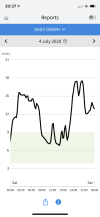Hi everyone,
I don’t quite know where to turn so hope it’s okay for me to ask here as I consider you experts.
I have a strong chance of developing Type 2 as I have had Gestational Diabetes twice (probably three times but it went undiagnosed during COVID times) and my Mum has it.
Having had my baby in November, I assumed my GD was gone but in March I took a random blood glucose reading and was mortified when it was 11.0, I immediately took it again and it was 9.0, then afterwards 8.5 and it stayed that way for a good couple of hours. By morning it was normal at 4ish, perhaps just under.
It scared the life out of me and I promptly cut out added sugar and started a low carb/high fat way of eating. I also tried to move more. In April I had my Fasting Bloods and HbA1c checked. Results were 3.8 fasting and a HbA1c of 27. I was so relieved and carried on, the weight dropped off at a rapid weight and I’ve lost two stone since and am now a healthy BMI.
Today I let my guard down a bit and had a portion of cake, tested my sugars after an hour and they were 9.6. I’m so confused and honestly, terrified. How can my blood sugars appear so comfortably within the normal range per my lab results, but spike so high off a piece of cake?
Could anybody please suggest what may be happening and if there’s anything I can do to help my health? I was really proud of what I’d achieved but it appears not to have helped.
Thank you so much
Xxx
I don’t quite know where to turn so hope it’s okay for me to ask here as I consider you experts.
I have a strong chance of developing Type 2 as I have had Gestational Diabetes twice (probably three times but it went undiagnosed during COVID times) and my Mum has it.
Having had my baby in November, I assumed my GD was gone but in March I took a random blood glucose reading and was mortified when it was 11.0, I immediately took it again and it was 9.0, then afterwards 8.5 and it stayed that way for a good couple of hours. By morning it was normal at 4ish, perhaps just under.
It scared the life out of me and I promptly cut out added sugar and started a low carb/high fat way of eating. I also tried to move more. In April I had my Fasting Bloods and HbA1c checked. Results were 3.8 fasting and a HbA1c of 27. I was so relieved and carried on, the weight dropped off at a rapid weight and I’ve lost two stone since and am now a healthy BMI.
Today I let my guard down a bit and had a portion of cake, tested my sugars after an hour and they were 9.6. I’m so confused and honestly, terrified. How can my blood sugars appear so comfortably within the normal range per my lab results, but spike so high off a piece of cake?
Could anybody please suggest what may be happening and if there’s anything I can do to help my health? I was really proud of what I’d achieved but it appears not to have helped.
Thank you so much
Xxx



